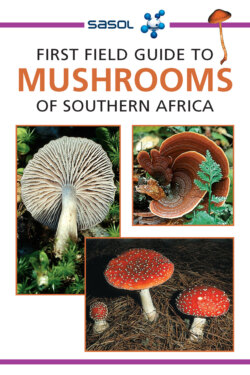Читать книгу First Field Guide to Mushrooms of Southern Africa - Margo Branch - Страница 5
На сайте Литреса книга снята с продажи.
Introduction
ОглавлениеIn Africa, mushrooms were once celebrated as a feast given by the rains before the crops matured, but in medieval Europe they were shrouded in mystery. This is not surprising: mushrooms pop up in dank, dark places as though from nothing. Some can cause death or hallucination, others glow in the dark. Some were named after toads, witches or fairies. The mysteriously sudden appearance of mushrooms was explained when scientists discovered that microscopic spores grow into a network of fine hairs to produce fruit-bodies; and that, after rain, these fruit-bodies absorb water, swell, burst to the surface and rapidly expand into mushrooms. A new cycle of spores is then shed, perpetuating the process.
Mushrooms are a type of fungus. The Fungi Kingdom includes mushrooms, brackets, yeasts, rusts and moulds. Unlike green plants, fungi cannot make their own food by photosynthesis. Instead, they obtain their nourishment from plant or animal material, which is dissolved by enzymes and ingested. While many fungi are small and simple in structure, mushrooms are the fruit-bodies of complex fungi. This guide introduces some larger fungi: mushrooms, brackets, puff-balls and stinkhorns.
Fungal activity has a great impact on our lives, both positively and negatively. Many fungi play important roles as decomposers, and return nutrients to the soil. Others, such as yeast, are useful for the production of bread, beer, cheese or yoghurt. Penicillin is a fungus that attacks bacterial diseases and is thus a commonly used medicine. Some fungi, however, are destructive and cause disease, like black spot on roses and athlete’s foot in humans.
A mushroom arises from the fine hairs that form the myceliumG.
